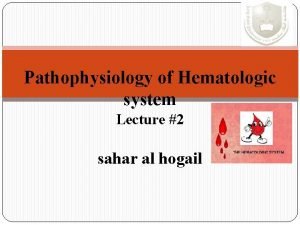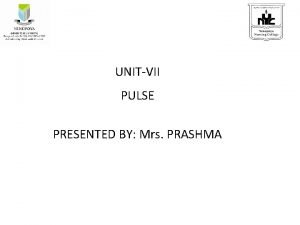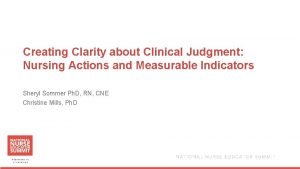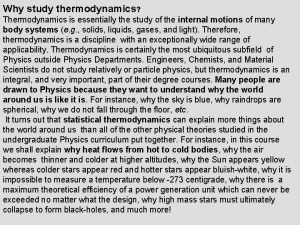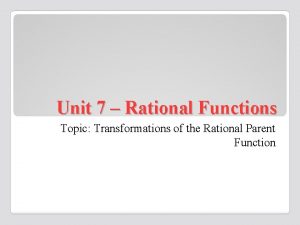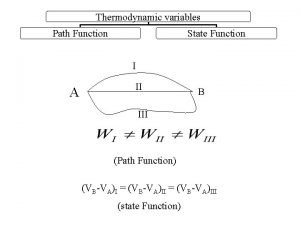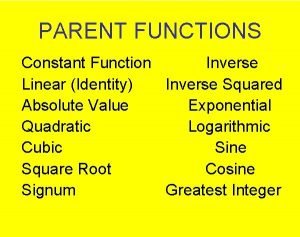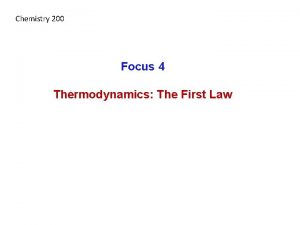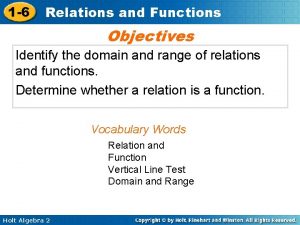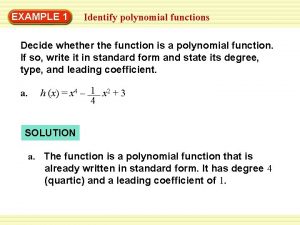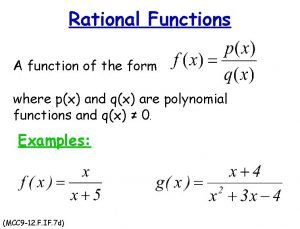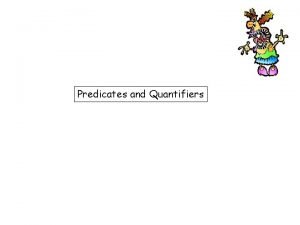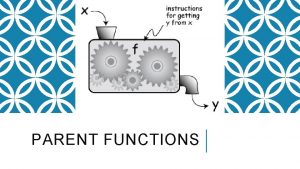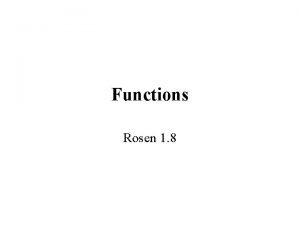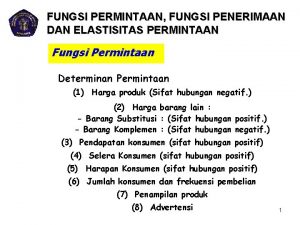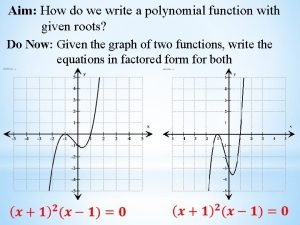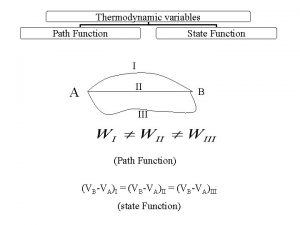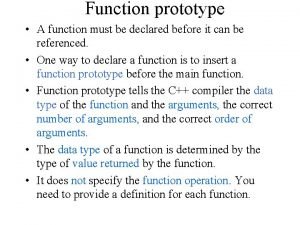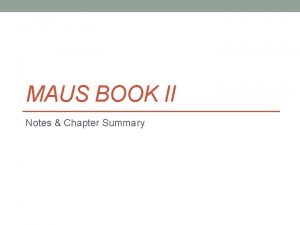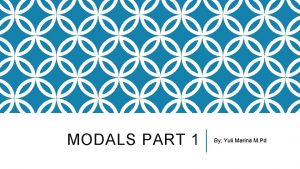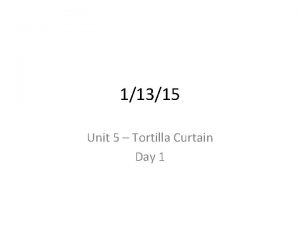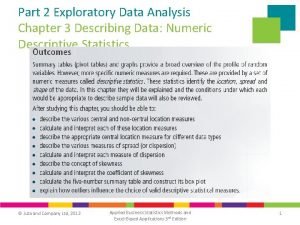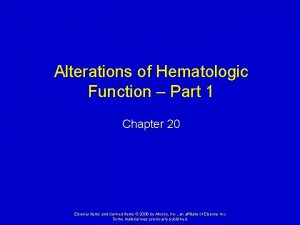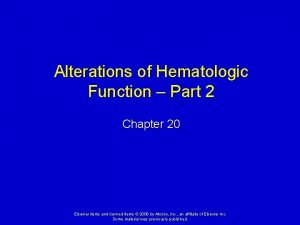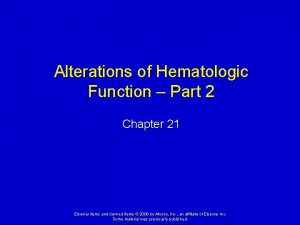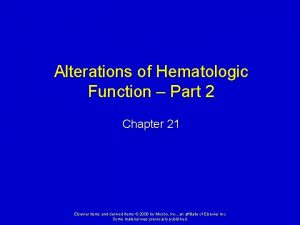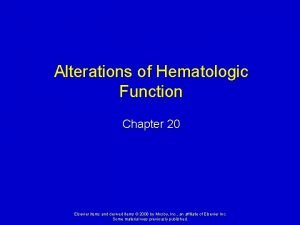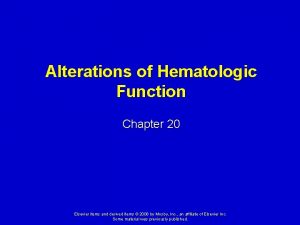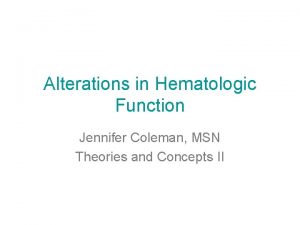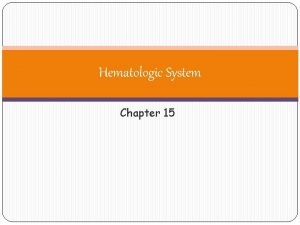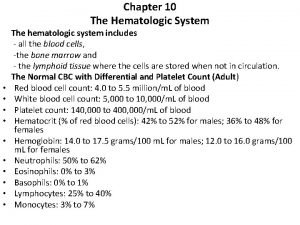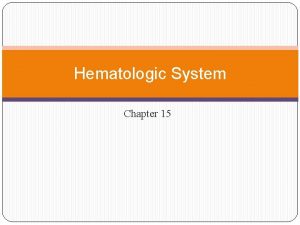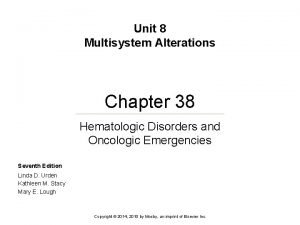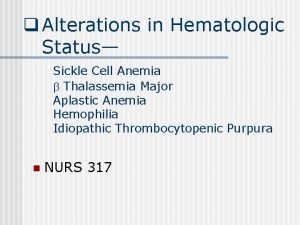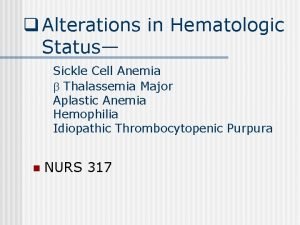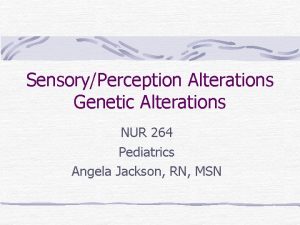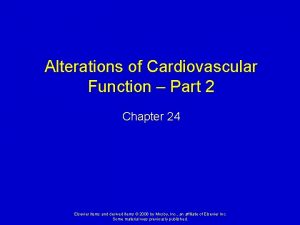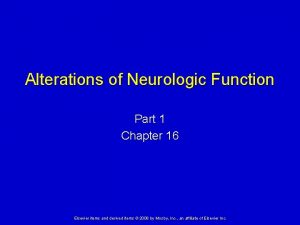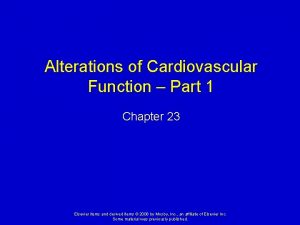Alterations of Hematologic Function Part 1 Chapter 21































































- Slides: 63

Alterations of Hematologic Function – Part 1 Chapter 21 Elsevier items and derived items © 2008 by Mosby, Inc. , an affiliate of Elsevier Inc. Some material was previously published.

Alterations of Erythrocyte Function Anemia - reduction in the total number of erythrocytes in the circulating blood or in the quality or quantity of hemoglobin, which causes a reduced oxygen-carrying capacity. Usually indicated by a hemoglobin level that falls below the lower normal limit. Normal hemoglobin values – male: 14 -18 g/dl; female: 12 -16 g/dl of blood. Causes a decline in oxygen transport, pallor, weakness, and exercise intolerance. Elsevier items and derived items © 2008 by Mosby, Inc. , an affiliate of Elsevier Inc. Some material was previously published.

Red Cell Assessments Hematocrit – the volume of red cells as a percent of total blood volume. Normal = 45% (+/- 5%). Mean corpuscular volume (MCV) – measures size of red blood cells. Mean corpuscular hemoglobin concentration (MCHC) – measures RBC hemoglobin content. Reticulocyte count – number of immature red cells in the blood. High counts indicate increased RBC production, perhaps due to RBC destruction or hemorrhage; low counts indicate problems with RBC synthesis. Elsevier items and derived items © 2008 by Mosby, Inc. , an affiliate of Elsevier Inc. Some material was previously published.

Classifications of Anemia By etiology: Ø Impaired erythrocyte production (aplastic) Ø Acute or chronic blood loss (hemorrhagic) Ø Increased erythrocyte destruction (hemolytic) Ø Combination of the above Elsevier items and derived items © 2008 by Mosby, Inc. , an affiliate of Elsevier Inc. Some material was previously published.

Classifications of Anemia By morphology: a. Size Ø Identified by terms that end in “-cytic” Ø Macrocytic, microcytic, normocytic b. Hemoglobin content Ø Identified by terms that end in “-chromic” Ø Normochromic and hypochromic Elsevier items and derived items © 2008 by Mosby, Inc. , an affiliate of Elsevier Inc. Some material was previously published.

Classifications of Anemia c. Other terms: Ø Anisocytosis - red cells are present in various sizes Ø Poikilocytosis - red cells are present in various shapes Elsevier items and derived items © 2008 by Mosby, Inc. , an affiliate of Elsevier Inc. Some material was previously published.

Elsevier items and derived items © 2008 by Mosby, Inc. , an affiliate of Elsevier Inc. Some material was previously published.

ACTIVITY 1. Having very small RBCs. 2. Having extra large RBCs. 3. Having RBCs with less hemoglobin than normal. 4. Having RBCs with the regular amount of hemoglobin. Elsevier items and derived items © 2008 by Mosby, Inc. , an affiliate of Elsevier Inc. Some material was previously published.

Physiologic Manifestations of Anemia Reduced oxygen-carrying capacity resulting in tissue hypoxia Variable symptoms based on severity and the ability for the body to compensate Classic anemia symptoms – pallor, fatigue, weakness, dyspnea, and dizziness Elsevier items and derived items © 2008 by Mosby, Inc. , an affiliate of Elsevier Inc. Some material was previously published.

Pallor Elsevier items and derived items © 2008 by Mosby, Inc. , an affiliate of Elsevier Inc. Some material was previously published.

Elsevier items and derived items © 2008 by Mosby, Inc. , an affiliate of Elsevier Inc. Some material was previously published.

Compensation Mechanisms in Anemia Hyperdynamic circulation – fluid moves from tissues into blood to compensate for decreased volume (fewer RBCs), so blood becomes less viscous and flows faster and more turbulently. Hypoxia causes dilation of vessels to increase peripheral blood flow. The heart beats faster and stronger to supply adequate blood and ventilation rate increases. Kidneys respond to hypoxia by secreting more erythropoietin. Elsevier items and derived items © 2008 by Mosby, Inc. , an affiliate of Elsevier Inc. Some material was previously published.

Macrocytic-Normochromic Anemias Also termed megaloblastic anemias Characterized by defective DNA synthesis Caused by deficiencies of vitamin B 12 (cobalamin) or folate Ø These are coenzymes for nuclear maturation and the DNA synthesis pathway Elsevier items and derived items © 2008 by Mosby, Inc. , an affiliate of Elsevier Inc. Some material was previously published.

Macrocytic-Normochromic Anemias Ribonucleic acid (RNA) processes occur at a normal rate Results in the unequal growth of the nucleus and cytoplasm and abnormally large cells. These defective erythrocytes die prematurely, reducing their numbers in the circulation. Elsevier items and derived items © 2008 by Mosby, Inc. , an affiliate of Elsevier Inc. Some material was previously published.

Macrocytic-Normochromic Anemias Normal RBCs Macrocytic cells Elsevier items and derived items © 2008 by Mosby, Inc. , an affiliate of Elsevier Inc. Some material was previously published.

Pernicious Anemia Caused by a lack of intrinsic factor (IF), made by the parietal cells of the stomach. Usually caused by chronic atrophic (autoimmune) gastritis. IF is required for vitamin B 12 absorption, so lack of IF results in vitamin B 12 deficiency. Elsevier items and derived items © 2008 by Mosby, Inc. , an affiliate of Elsevier Inc. Some material was previously published.

Pernicious Anemia Manifestations: Typical anemia symptoms Neurologic manifestations occur due to vitamin B 12 deficiency Ø Nerve demyelination causes loss of nerve fibers in spinal cord Ø Results in paresthesia (tingling), muscle weakness, and ataxia (lack of muscle control) Elsevier items and derived items © 2008 by Mosby, Inc. , an affiliate of Elsevier Inc. Some material was previously published.

Pernicious Anemia Manifestations: Others: Ø Loss of appetite Ø Abdominal pain Ø Beefy red tongue (atrophic glossitis) Ø Splenic enlargement Elsevier items and derived items © 2008 by Mosby, Inc. , an affiliate of Elsevier Inc. Some material was previously published.

Glossitis Elsevier items and derived items © 2008 by Mosby, Inc. , an affiliate of Elsevier Inc. Some material was previously published.

Pernicious Anemia Diagnosis Ø Includes use of Schilling test for cobalamin absorption. Treatment Ø Parenteral or high oral doses of vitamin B 12. Elsevier items and derived items © 2008 by Mosby, Inc. , an affiliate of Elsevier Inc. Some material was previously published.

Folate Deficiency Anemia Absorption of folate occurs in the upper small intestine (not dependent on a factor like IF). Folate deficiency is most common in alcoholics or in people on diets low in vegetables. Similar symptoms to pernicious anemia except neurologic manifestations generally not seen. Treatment requires daily oral administration of folate. Elsevier items and derived items © 2008 by Mosby, Inc. , an affiliate of Elsevier Inc. Some material was previously published.

ACTIVITY Why do patients with pernicious anemia or folate deficiency anemia have RBCs that are abnormally large, but still have a normal amount of hemoglobin? Elsevier items and derived items © 2008 by Mosby, Inc. , an affiliate of Elsevier Inc. Some material was previously published.

Microcytic-Hypochromic Anemias Characterized by red cells that are abnormally small and contain reduced amounts of hemoglobin Related to: Ø Disorders of iron metabolism Ø Disorders of porphyrin and heme synthesis Ø Disorders of globin synthesis Elsevier items and derived items © 2008 by Mosby, Inc. , an affiliate of Elsevier Inc. Some material was previously published.

Microcytic-Hypochromic Anemias Normal RBCs Microcytic cells Hypochromic cells Elsevier items and derived items © 2008 by Mosby, Inc. , an affiliate of Elsevier Inc. Some material was previously published.

Iron Deficiency Anemia Most common type of anemia worldwide. Causes: Ø Prolonged bleeding (as from GI tract) Ø Nutritional iron deficiency Progression of iron deficiency causes: Ø Brittle, thin, coarsely ridged, and spoon- shaped nails Ø Red, sore, and painful tongue Elsevier items and derived items © 2008 by Mosby, Inc. , an affiliate of Elsevier Inc. Some material was previously published.

Spoon-shaped Nail Elsevier items and derived items © 2008 by Mosby, Inc. , an affiliate of Elsevier Inc. Some material was previously published.

Elsevier items and derived items © 2008 by Mosby, Inc. , an affiliate of Elsevier Inc. Some material was previously published.

Iron Deficiency Anemia Diagnosis Ø Includes measurement of iron stores, either directly by bone marrow biopsy or indirectly by measuring serum ferritin, transferrin saturation or iron-binding capacity. Treatment Ø Identify and treat sites of blood loss; administer iron replacement therapy. Elsevier items and derived items © 2008 by Mosby, Inc. , an affiliate of Elsevier Inc. Some material was previously published.

Sideroblastic Anemia Group of disorders characterized by inefficient iron uptake which causes abnormal hemoglobin synthesis. Tissue levels of iron are high and iron overload may occur. Ringed sideroblasts within the bone marrow are diagnostic. Ø Sideroblasts are erythroblasts that contain iron granules that have not been incorporated into hemoglobin. Elsevier items and derived items © 2008 by Mosby, Inc. , an affiliate of Elsevier Inc. Some material was previously published.

Ringed Sideroblasts Elsevier items and derived items © 2008 by Mosby, Inc. , an affiliate of Elsevier Inc. Some material was previously published.

Sideroblastic Anemia Manifestations: Ø Typical anemia symptoms Ø Hepatomegaly and splenomegaly (enlarged liver and spleen) Ø Bronze-tinted skin (hemosiderosis) Elsevier items and derived items © 2008 by Mosby, Inc. , an affiliate of Elsevier Inc. Some material was previously published.

Sideroblastic Anemia Management includes removal of the underlying cause, plus: Ø Transfusions (if needed) Ø Management of iron overload via phlebotomy or use of iron-chelating agents Ø Monitoring for development of dangerous complications: • Myelodysplastic syndrome [MDS] - abnormal marrow proliferation, which may then convert to acute myeloblastic leukemia Elsevier items and derived items © 2008 by Mosby, Inc. , an affiliate of Elsevier Inc. Some material was previously published.

ACTIVITY Why do patients with iron deficiency anemia or sideroblastic anemia have RBCs that are abnormally small, with less hemoglobin than normal (microcytic and hypochromic)? Elsevier items and derived items © 2008 by Mosby, Inc. , an affiliate of Elsevier Inc. Some material was previously published.

Normocytic-Normochromic Anemias Characterized by red cells that are relatively normal in size and hemoglobin content but insufficient in number Elsevier items and derived items © 2008 by Mosby, Inc. , an affiliate of Elsevier Inc. Some material was previously published.

Aplastic Anemia Rare condition that arises from failure of the bone marrow stem cells. Etiology – rare congenital cases; more commonly an acquired disorder resulting from: Ø Infiltrative disorders of bone marrow Ø Autoimmune attack against bone marrow Ø Infections Ø Toxic insults to the marrow Elsevier items and derived items © 2008 by Mosby, Inc. , an affiliate of Elsevier Inc. Some material was previously published.

Aplastic Anemia Pancytopenia – if a common stem cell precursor is affected, there is a deficiency of all types of blood cells. Ø Leukopenia results in susceptibility to infection. Ø Thrombocytopenia results in bleeding disorders. Pure red cell aplasia – if only the precursors of the erythrocytes are affected, then anemia is the only outcome. Elsevier items and derived items © 2008 by Mosby, Inc. , an affiliate of Elsevier Inc. Some material was previously published.

Posthemorrhagic Anemia Due to acute blood loss from the vascular space, either externally or internally. Manifestations: Ø Loss of blood volume causes hypotension, tachycardia, poor peripheral circulation, and shock. Ø Decrease in the oxygen-carrying capacity of the blood can result in severe tissue ischemia. Ø Death can occur if blood loss exceeds 40 -50% of plasma volume. Elsevier items and derived items © 2008 by Mosby, Inc. , an affiliate of Elsevier Inc. Some material was previously published.

Posthemorrhagic Anemia Management: Ø Stop blood loss. Ø Administration of fluid replacement and transfusions of blood or packed red blood cells. Elsevier items and derived items © 2008 by Mosby, Inc. , an affiliate of Elsevier Inc. Some material was previously published.

Hemolytic Anemia Characterized by premature destruction of red blood cells. Can be inherited or acquired. Elsevier items and derived items © 2008 by Mosby, Inc. , an affiliate of Elsevier Inc. Some material was previously published.

Microangiopathic Hemolytic Anemia Elsevier items and derived items © 2008 by Mosby, Inc. , an affiliate of Elsevier Inc. Some material was previously published.

Hemolytic Anemia Acquired hemolytic anemias Ø Most often the result of autoimmunity to erythrocytes. Ø Antibodies to erythrocytes cause degradation of the cell membranes and destruction of the erythrocytes by the spleen. Ø Can be initiated by certain drugs (e. g. , penicillin) and infections (e. g. , Mycoplasma pneumoniae). Ø Often idiopathic or occurs in conjunction with an underlying disease such as lymphoma. Elsevier items and derived items © 2008 by Mosby, Inc. , an affiliate of Elsevier Inc. Some material was previously published.

Hemolytic Anemia Manifestations - typical anemia symptoms accompanied by those of any underlying condition. Ø Jaundice occurs due to accumulation of bilirubin from lysed RBCs. Elsevier items and derived items © 2008 by Mosby, Inc. , an affiliate of Elsevier Inc. Some material was previously published.

Hemolytic Anemia Diagnostic findings include: Ø Low hematocrit and hemoglobin Ø Increased reticulocyte count Ø Presence of schistocytes (abnormal cell shapes) on blood smear Ø Positive Coombs test (detects red blood cell autoantibodies) Elsevier items and derived items © 2008 by Mosby, Inc. , an affiliate of Elsevier Inc. Some material was previously published.

Hemolytic Anemia Management includes: Ø Treatment of associated infection or underlying condition and/or removal of any offending drug. Ø In severe cases, steroid administration or splenectomy may be necessary. Elsevier items and derived items © 2008 by Mosby, Inc. , an affiliate of Elsevier Inc. Some material was previously published.

Sickle Cell Anemia Autosomal recessive disorder that causes an abnormality in hemoglobin synthesis. In U. S. it occurs most commonly in African Americans. Elsevier items and derived items © 2008 by Mosby, Inc. , an affiliate of Elsevier Inc. Some material was previously published.

Sickle Cell Anemia Sickle cell disease results in formation of hemoglobin S (rather than the normal hemoglobin A). Ø Deoxygenation or dehydration causes hemoglobin S to elongate and cells take on sickle shape. Ø Sickled cells lodge in capillaries and cause obstruction, tissue ischemia and infarction. Ø Sickled cells are filtered out of the blood and destroyed by the spleen. Elsevier items and derived items © 2008 by Mosby, Inc. , an affiliate of Elsevier Inc. Some material was previously published.

Sickle Cell Anemia Elsevier items and derived items © 2008 by Mosby, Inc. , an affiliate of Elsevier Inc. Some material was previously published.

Sickle Cell Anemia Sickle cell trait: Ø Individual inherits only one defective gene (heterozygous) Ø Often asymptomatic Ø May experience recurrent episodes of anemia associated with pain and tissue ischemia. Elsevier items and derived items © 2008 by Mosby, Inc. , an affiliate of Elsevier Inc. Some material was previously published.

Sickle Cell Anemia Sickle cell anemia: Ø Individual inherits the defective gene from both parents (homozygous) Ø Often life threatening, accompanied by pain crises, organ infarction, and profound destruction of erythrocytes (aplastic crisis). Elsevier items and derived items © 2008 by Mosby, Inc. , an affiliate of Elsevier Inc. Some material was previously published.

Sickle Cell Anemia Evaluation - diagnosis is made by: Ø Establishing a family history Ø Detecting sickled erythrocytes in the blood Ø Documenting hemoglobin S through the process of hemoglobin electrophoresis Elsevier items and derived items © 2008 by Mosby, Inc. , an affiliate of Elsevier Inc. Some material was previously published.

Sickle Cell Anemia Management: Ø Sickle cell trait - good hydration and prompt treatment of infections Elsevier items and derived items © 2008 by Mosby, Inc. , an affiliate of Elsevier Inc. Some material was previously published.

Sickle Cell Anemia Management: Ø Sickle cell anemia – • Pain management • Emergency transfusion • Oxygen, intravenous fluids, and antibiotics • Hospitalization may be indicated on recurring basis. • Administration of hydroxyurea, which stimulates the production of hemoglobin F, may improve erythrocyte function and reduce the symptoms and complications of sickle cell anemia. Elsevier items and derived items © 2008 by Mosby, Inc. , an affiliate of Elsevier Inc. Some material was previously published.

Anemia of Chronic Inflammation Mild to moderate anemia seen in: Ø AIDS, rheumatoid arthritis, lupus erythematosus, hepatitis, renal failure, and malignancies Pathologic mechanisms: Ø Decreased erythrocyte life span Ø Ineffective bone marrow response to erythropoietin Ø Altered iron metabolism Elsevier items and derived items © 2008 by Mosby, Inc. , an affiliate of Elsevier Inc. Some material was previously published.

ACTIVITY 1. Which types of anemia may be caused by autoimmune reactions? 2. Which types of anemia are treated with dietary supplementation? Elsevier items and derived items © 2008 by Mosby, Inc. , an affiliate of Elsevier Inc. Some material was previously published.

Myeloproliferative RBC Disorders Polycythemia Ø Overproduction of red blood cells. Relative polycythemia Ø Result of dehydration. Ø Fluid loss results in relative increases of red cell counts, hemoglobin and hematocrit values. Elsevier items and derived items © 2008 by Mosby, Inc. , an affiliate of Elsevier Inc. Some material was previously published.

Absolute Polycythemia Secondary absolute polycythemia Ø Overproduction of red blood cells that results from an increase in erythropoietin as either: • a normal response to chronic hypoxia • an inappropriate response to erythropoietinsecreting tumors. Elsevier items and derived items © 2008 by Mosby, Inc. , an affiliate of Elsevier Inc. Some material was previously published.

Polycythemia Vera (PV) Primary absolute polycythemia = PV Polycythemia vera is an abnormal proliferation of bone marrow stem cells characterized by: Ø Overproduction of red cells Ø Often with increased white cells and platelets and splenomegaly (spleen enlargement) Elsevier items and derived items © 2008 by Mosby, Inc. , an affiliate of Elsevier Inc. Some material was previously published.

Polycythemia Vera Elsevier items and derived items © 2008 by Mosby, Inc. , an affiliate of Elsevier Inc. Some material was previously published.

Polycythemia Vera (PV) This results in: Ø Hyperviscosity of the blood Ø Hypercoagulability Ø Poor tissue perfusion, tissue ischemia and possible organ infarction Elsevier items and derived items © 2008 by Mosby, Inc. , an affiliate of Elsevier Inc. Some material was previously published.

Polycythemia Vera (PV) Manifestations: Ø Vascular congestion, plethora (red face, hands, feet, ears and mucous membranes), headache, visual disturbances, neurologic deficits, intense itching upon exposure to heat or water. Sequelae: Ø Increased risk of cerebral thrombosis, angina, and even heart failure (in extreme cases). Elsevier items and derived items © 2008 by Mosby, Inc. , an affiliate of Elsevier Inc. Some material was previously published.

Polycythemia Vera (PV) Diagnosis of polycythemia vera is made by documenting: Ø Elevated hematocrit Ø Elevated total cell volume Ø Increased cellularity of the bone marrow. Elsevier items and derived items © 2008 by Mosby, Inc. , an affiliate of Elsevier Inc. Some material was previously published.

Polycythemia Vera (PV) Treatment for polycythemia vera includes: Ø Regular phlebotomy Ø Suppression of erythropoiesis using radioactive phosphorus (increases risk of acute myeloid leukemia) or hydroxyurea. Ø Can result in remission and survival time of 15+ years. Without treatment 50% die within 18 months of thrombosis or hemorrhage. Elsevier items and derived items © 2008 by Mosby, Inc. , an affiliate of Elsevier Inc. Some material was previously published.

ACTIVITY 1. How is polycythemia vera similar to cancer? 2. Why do you think polycythemia is not considered to be a cancer of the bone marrow? Elsevier items and derived items © 2008 by Mosby, Inc. , an affiliate of Elsevier Inc. Some material was previously published.
 Endocrine and hematologic emergencies
Endocrine and hematologic emergencies Assessment of hematologic system
Assessment of hematologic system Hematologic system definition
Hematologic system definition Hematologic system assessment
Hematologic system assessment Alterations of chromosome structure
Alterations of chromosome structure Alterations in various aspects of society over time...
Alterations in various aspects of society over time... Pulse characteristics
Pulse characteristics Clinical judgement sample items a ati
Clinical judgement sample items a ati Anatomical location
Anatomical location Unauthorised alterations to common property
Unauthorised alterations to common property Alterations in the structure of an organism
Alterations in the structure of an organism Alteration in urinary elimination
Alteration in urinary elimination Part whole model subtraction
Part whole model subtraction Unit ratio definition
Unit ratio definition Brainpop ratios
Brainpop ratios Technical description meaning
Technical description meaning Different parts of a bar
Different parts of a bar The part of a shadow surrounding the darkest part
The part of a shadow surrounding the darkest part Part to part variation
Part to part variation Parts of seed labeled
Parts of seed labeled What is the sepal function in a flower
What is the sepal function in a flower Function of anther
Function of anther Troubleshooting
Troubleshooting 14 parts of a microscope
14 parts of a microscope Unit test review algebra 1
Unit test review algebra 1 Parts of the plants objectives
Parts of the plants objectives What are the six parts of the plant?
What are the six parts of the plant? Why study thermodynamics
Why study thermodynamics Rational functions parent function
Rational functions parent function Asymptote transformations
Asymptote transformations Pressure is state function or path function
Pressure is state function or path function Cosine parent function table
Cosine parent function table Linear table
Linear table Exponential parent function graph
Exponential parent function graph Pressure is state function or path function
Pressure is state function or path function 1-6 relations
1-6 relations Linear parent function graph
Linear parent function graph Absolute value function to piecewise function
Absolute value function to piecewise function How to identify a polynomial function
How to identify a polynomial function Rational fucntion
Rational fucntion How a predicate function become a propositional function?
How a predicate function become a propositional function? Cubic parent function
Cubic parent function One to one and onto
One to one and onto Inverse functions logarithmic and exponential
Inverse functions logarithmic and exponential Composite fx
Composite fx Fungsi penerimaan
Fungsi penerimaan Polynomial function parent function
Polynomial function parent function Heat capacity is path function
Heat capacity is path function Power function
Power function What is function prototype
What is function prototype To kill a mockingbird chapters 1-6 quiz
To kill a mockingbird chapters 1-6 quiz Maus part 2 chapter 1 summary
Maus part 2 chapter 1 summary Chapter review motion part a vocabulary review answer key
Chapter review motion part a vocabulary review answer key Gulliver's travels laputa summary
Gulliver's travels laputa summary To kill a mockingbird chapter 1
To kill a mockingbird chapter 1 Chapter 9 modals part 1
Chapter 9 modals part 1 Chapter 5 maus summary
Chapter 5 maus summary 2. part two—preparing a chart of accounts
2. part two—preparing a chart of accounts Chapter 2 parts of research
Chapter 2 parts of research 1984 chapter 1 part 2
1984 chapter 1 part 2 1984 discussion questions and answers
1984 discussion questions and answers The tortilla curtain part 1 chapter 5
The tortilla curtain part 1 chapter 5 1984 chapter 1 questions and answers
1984 chapter 1 questions and answers Business statistics i com part 2 chapter 3
Business statistics i com part 2 chapter 3


